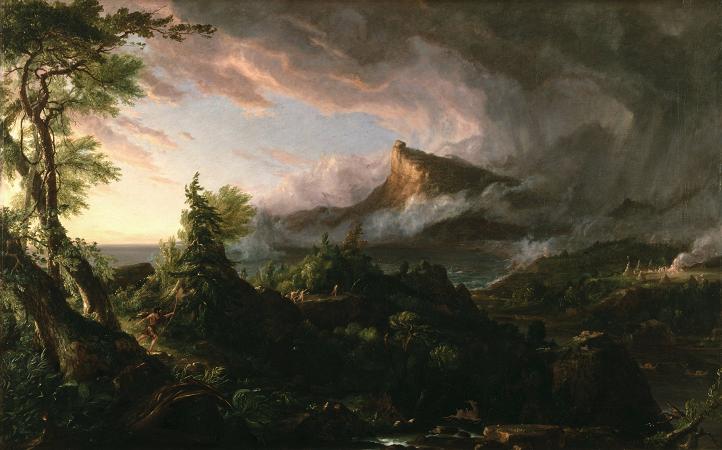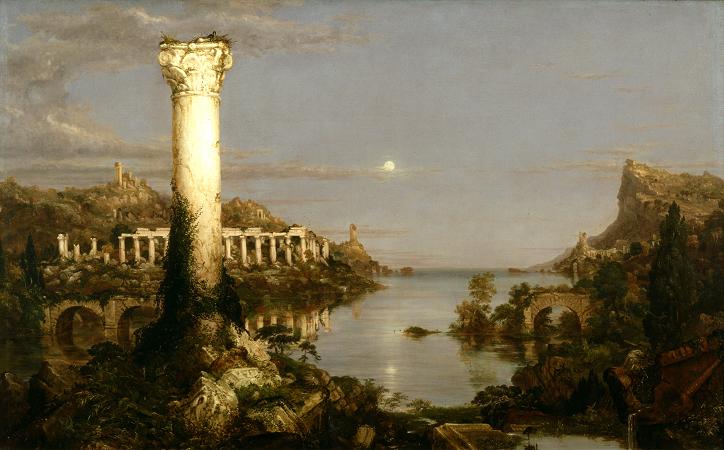Course of Empire (1836). The Course of Empire is a series of five paintings created by Thomas Cole in the years 1833-1836. It is notable in part for reflecting popular American sentiments of the times, when many saw pastoralism as the ideal phase of human civilization, fearing that empire would lead to gluttony and inevitable decay. The theme of cycles is one that Cole returned to frequently, such as in his The Voyage of Life series. The Course of Empire comprises the following works: The Course of Empire-The Savage State; The Arcadian or Pastoral State; The Consummation of Empire; Destruction; and Desolation. All the paintings are 39.5 inches by 63.5 inches except The Consummation of Empire which is 51 by 76. The series of paintings depicts the growth and fall of an imaginary city, situated on the lower end of a river valley, near its meeting with a bay of the sea. The valley is distinctly identifiable in each of the paintings, in part because of an unusual landmark: a large boulder is situated atop a crag overlooking the valley. Some critics believe this is meant to contrast the immutability of the earth with the transience of man. A direct source of literary inspiration for The Course of Empire paintings is Byron's Childe Harold's Pilgrimage. Cole quoted lines from Canto IV in his newspaper advertisements for the series: First freedom and then Glory-when that fails, Wealth, vice, corruption. Cole designed these paintings to be displayed prominently in the picture gallery on the third floor of the mansion of his patron, Luman Reed, at 13 Greenwich Street, New York City. The layout was approximately as shown here, according to Cole's installation diagram. The series was acquired by The New-York Historical Society in 1858 as a gift of the New-York Gallery of Fine Arts. The first painting, The Savage State, shows the valley from the shore opposite the crag, in the dim light of a dawning stormy day. Clouds and mist shroud much of the distant landscape, hinting at the uncertain future. A hunter clad in skins hastens through the wilderness, pursuing a fleeing deer; canoes paddle up the river; on the far shore can be seen a clearing with a cluster of tipis around a fire, the nucleus of the city that is to be. The visual references are those of aboriginal North American life. This painting depicts the ideal state of the natural world. It is a healthy world, unchanged by humanity. In the second painting, The Arcadian or Pastoral State, the sky has cleared and we are in the fresh morning of a day in spring or summer. The viewpoint has shifted further down the river, as the crag with the boulder is now on the left-hand side of the painting; a forked peak can be seen in the distance beyond it. Much of the wilderness has given way to settled lands, with plowed fields and lawns visible. Various activities go on in the background: plowing, boat-building, herding sheep, dancing; in the foreground, an old man sketches what may be a geometrical problem with a stick. On a bluff on the near side of the river, a megalithic temple has been built, and smoke arises from it. The images reflect an idealized, pre-urban ancient Greece. This work shows humanity at peace with the land. The environment has been altered, but not so much so that it or its inhabitants are in danger. Yet the construction of the warship and the concerned mother watching as her child sketches a soldier, herald the emerging imperial ambitions. The third painting, The Consummation of Empire, shifts the viewpoint to the opposite shore, approximately the site of the clearing in the first painting. It is noontide of a glorious summer day. Both sides of the river valley are now covered in colonnaded marble structures, whose steps run down into the water. The megalithic temple seems to have been transformed into a huge domed structure dominating the river-bank. The mouth of the river is guarded by two pharoi, and ships with lateen sails go out to the sea beyond. A joyous crowd gathers on the balconies and terraces as a scarlet-robed king or victorious general crosses a bridge connecting the two sides of the river in a triumphant procession. In the foreground, an elaborate fountain gushes. The look of the painting suggests the height of ancient Rome. The decadence seen in every detail of this cityscape foreshadows the inevitable fall of this mighty civilization.
more...







